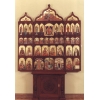|
 The home
iconostasis in Orthodox families is must-have attribute of the interior to be
appropriate to family values. Fashion and religion seem to differ in vital
positions and policies though when it comes to iconostasis this rule is void.
Previous Orthodox families did with a corner in a single room with icons to
pray, and today it is not good enough to place icons on the correct position on
the wooden shelf. The major criterion to observe is exclusivity.
Yes, even when it comes to do with
religious attributes and this trend is considered by most people who go to
purchase or custom icons. This holy thing should be magnificent and sacred simultaneously. The home
iconostasis in Orthodox families is must-have attribute of the interior to be
appropriate to family values. Fashion and religion seem to differ in vital
positions and policies though when it comes to iconostasis this rule is void.
Previous Orthodox families did with a corner in a single room with icons to
pray, and today it is not good enough to place icons on the correct position on
the wooden shelf. The major criterion to observe is exclusivity.
Yes, even when it comes to do with
religious attributes and this trend is considered by most people who go to
purchase or custom icons. This holy thing should be magnificent and sacred simultaneously.
Traditionally
the iconostasis used in churches is the altar partition that goes from the
north to south sides of the temple. The iconostasis is made from the several
rows of icons placed in the correct consequence that should be continuous
ideally. The iconostasis has the functional feature to part the altar side of
the church from the other space.
The
iconostasis applied by the Russians consists of five rows. The lower row is
called the rite. It is recognizable with the two folds to the Holy gates with
the image of the Annunciation Day and four evangelists. The icons of the mother
of God and that of the Saviour are placed in the left and in the right.
The second row
called deesis follows the rite. The word deesis stands for praying from the
Greek language and therefore the icon of the Christ is placed in the center of
the deesis with the icons of praying Mother of God, John the Baptist, Michael
and Gabriel, Archangels and other apostles. The apostles number in twelve
sometimes, sometimes there are two of them, those of Peter and Paul.
The third row
proposed as holiday row presents the crucial events in the Gospel history,
particularly Twelve Great Feasts. The forth, prophetic row has the icons of prognostication
of Christ’s birth in the Old Testament: David and Solomon Kings, St. Elias
prophet and others.
The fifth row
is called to be father’s. The row demonstrates the icons with the images from
Old Testament who were ancestors to Christ, beginning from Adam and Eve. The fifth
row often has the icon of the Trinity of the Old Testament depicting the
occurrence of three angels to Abraham. The iconostasis is ended with the cross
or the cross-shaped crucifix.
The Orthodox
priests regularly make statements in popular magazines or web sites with how to
place home iconostasis adequately. They recommend that basic sacred icon to
place be those of Mother of God and the Savior. And here the model does not
matter. So, the image of the Mother of God as Tenderness or the Virgin
Hodegetria is allowed to place at home iconostasis in equal positions. The first
icon specifies the face touch of the mother of Gold and the Child Jesus, the
other icon depicts the Mother of God pointing the way to the Savior.
The icon of
the St. Nicholas the Wonderworker, the St. Prophet
Elijah, Peter and Paul, Apostles, Great Martyr St. George the Victory-bearer
and the Great Martyr St. Panteleimon can be placed in the iconostasis. The next
icons can be added to the rows but not obligatory, to create the whole
composition, namely the icons of St. Evangelists, St.
John the Precurser, the Archangels Michael and Gabriel and several holy icons. The
final stroke is the icons with the images of local holy persons and saints
whose names are given to family members.
The home
iconostasis can be placed at the wall or onto the floor, with frontal or
angular look. Today craftsmen are qualified enough to make iconostasis for
private use designed to match the interior of the place, even if the decoration
is too extravagant.
Mostly customers
require making a structure to later place the family relics and newer icons.
Design workshops
and crews make efforts to develop the range of icons to create iconostasis of different
price range to allow any believer acquire the things. The iconostasis of economic
models are made from non-expensive wood and decorated with carving only. They small
in size and can room six icons, on the average they cost from $30 to $100 USD.
The average
price bracket includes more solid iconostasis resembling a small wardrobe or a
bookcase. They are made from fine wood as oak, beech, plane tree, nut tree finished
in tint lime tree or cherry tree and metal gilded inlays. Such work is ranges from
$150 to $ 5000 USD.
Most expensive
exclusive iconostasis are made as custom in limited edition. And the customer
can express everything they wish to have in the iconostasis. The iconostasis can
be finished with marble panels, enamel, gilding, semi-precious gems (or
precious), glazed or porcelain ornamented tiles. The low margin in price range
is $5000 USD and higher whereas wealthy customers demand confidentiality.
|